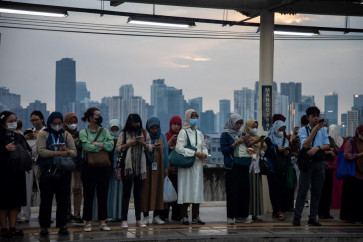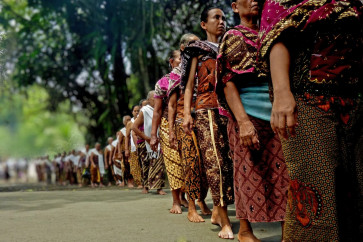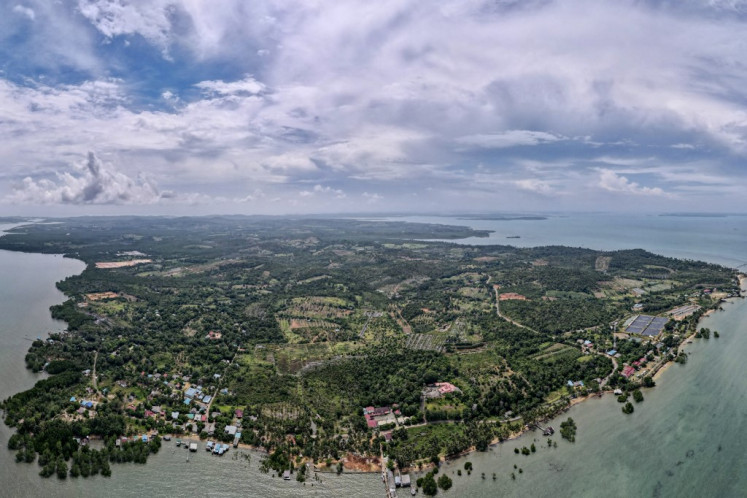Popular Reads
Top Results
Can't find what you're looking for?
View all search resultsPopular Reads
Top Results
Can't find what you're looking for?
View all search resultsRaising forest fairies
Metamorphosis pending: This tiny butterfly egg will hatch as a caterpillar, transform within a cocoon then end its life cycle after mating as a butterfly
Change text size
Gift Premium Articles
to Anyone
M
span class="inline inline-none">Metamorphosis pending: This tiny butterfly egg will hatch as a caterpillar, transform within a cocoon then end its life cycle after mating as a butterfly.
In gardens and jungles across the archipelago can be found some of the world's most beautiful butterflies.
Almost as gorgeous as flowers themselves, the insects flit from bloom to bloom, pollinating flora over a large area and aiding the work of bees in maintaining the ecology of the forest.
However, with the increasing loss of their jungle habitat, some Indonesian butterflies are at risk of extinction, according to Usman Ode.
The butterfly conservationist and hobbyist takes as example the West Javan Papilio langsacus, a swallowtail butterfly that is the rarest of its kind in Indonesia.
'Over 20 years I have found only four of these butterflies ' three were male,' Usman says. 'Food for these butterflies is very difficult to find. We needed a very specific feeding plan before we could breed these butterflies.'
The Papilio langsacus was only found in the jungle near Mount Galunggung before it erupted, he adds. 'That forest was lost, so they migrated to the forests of Sukabumi.'
Always hungry: Bambang and one of the caterpillars he calls 'eating machines'.
Working to protect these forest fairies, Usman and a group of other hobbyists established a captive-breeding and release butterfly garden in Bali's Tabanan regency almost two decades ago.
Open to the public, the park affords visitors a chance to see butterflies in various stages of their life cycles, as eggs laid on leaves, to the caterpillars that emerge to feed on those leaves, through the metamorphosis of the caterpillar into a pupa and finally its rebirth as an imago, or adult, butterfly.
'We opened the butterfly park because butterflies were a hobby for us,' Usman said. 'I grew interested in butterflies as a young boy in Ambon ' I was about 14, so that was a long time ago.'
'I was interested in the colors, like the electric blue of the 12-centimeter Ambon ulysses butterfly ['¦] As a boy I would swim and they would dart along the river,' he continues.
He is referring to the famous Papilio ulysses swallowtail butterfly, endemic to Australiasia, which is one of the species bred at the park.
The group recently established a second ulysses butterfly breeding center in Ambon, where the insects will be released into the wild. 'That is the best butterfly of Ambon ' the grande dame of Ambon.'
From the center in Bali, adult imagos of local species ' such as the magnificent barong butterfly, with their 25-centimeter wingspans ' are released into the wild.
Bali Butterfly Park manager Bambang Ardianto says that they only release species native to the island into the wild. 'Non-Balinese butterflies could impact negatively on those species, so they are not released from our breeding program.'
Glittering: Gem-like cocoons reflect predators, scaring them away.
Bambang, who is the son of one of the park's founders, believes the breeding program is of import for conserving Indonesia's diverse butterfly species, which are at risk due to loss of their habitats.
'As long as we have jungles, we will have butterflies,' according to Bambang. 'The more forests there are, the more plants there will be ' so more butterflies.' Species under threat include the Troides andromache, found only in Kalimantan. 'We worry, of course, that we will have no butterflies in some places, because there will be no forests as habitat.'
Breeding a range of species at the park is the organization's way of responding to, the threats to the wild population of butterflies, he adds. 'We are very concerned for the future of forests. We don't have any power to stop the loss of jungles ['¦] We are concerned about the future of Indonesia's butterflies.'
Bambang, too, said he developed an interest in butterflies as a youth. 'My main interest was their life cycles and their need for specific foods ['¦] I thought their life cycles were very beautiful and very short. I watched caterpillars eating through leave like little machines. As long as they lived, they ate constantly.
'I really liked caterpillars and their non-stop eating,' he adds.
One of the park's goals is to share knowledge of butterflies. Its museum displays hundreds of different specimens from Indonesia and from across the world.
Strolling through the park's net-enclosed gardens, visitors can see more than 15 species traveling from flower to flower and flitting through the garden's canopy.
Moving on: One of the myriad forms caterpillars take before transforming into butterflies.
A visit to the enclosed breeding room allows a close-up view of recently metamorphasized butterflies drying their wings before release into the gardens. Here also are hundreds of cocoons.
Sri Wayuni, who has worked in the center for eight years, points out the different types of cocoons that each species creates.
'These cocoons that look like shiny mirrors are to scare off predators,' she says of exquisite cocoons that glitter like gems. 'As a predator comes close they see themselves reflected and are frightened away.'
She points also to huge female specimen of a Barong butterfly. 'On her wings are snake-head designs to warn off prey. She was hatched this morning and will live only five days.'
'It's interesting working with butterflies because of their beautiful colors and forms and they are not dangerous. They are also rare and growing scarcer in the wild because of pollution and loss of habitat,' says Sri.
Her favorite? It's the dazzlingly verdant Ornithoptera priamus subspecies found in Ambon, commonly known as the common green birdwing. 'I love green, the color of the natural world.'
Imago: Bambang and several freshly hatched barong butterflies in the Bali Butterfly Park's breeding room.
Resplendant: Usman Ode, a founder of the Bali Butterfly Park with an Ambonese bird-wing butterfly bred at the Tabanan park.
Immense: Sri Wayuni releases a female barong butterfly with a 25-centimeter-wingspan into the park's gardens.
' Images by J.B.Djwan

















